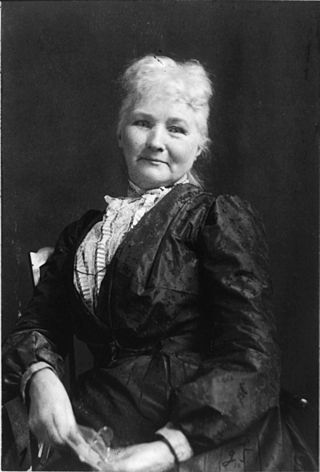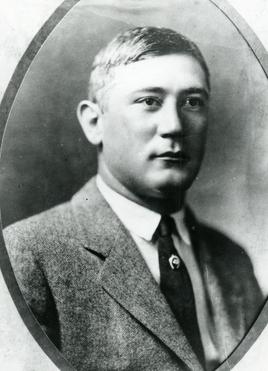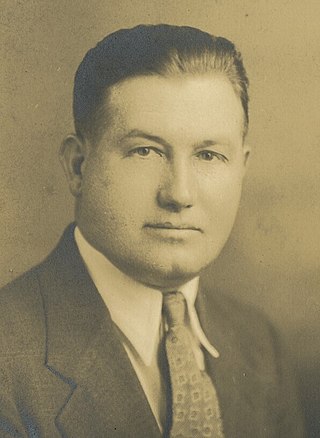
Matewan is a town in Mingo County, West Virginia, United States at the confluence of the Tug Fork River and Mate Creek. The population was 412 at the 2020 census, down from 499 in 2010. The Norfolk Southern Railway's Pocahontas District passes through the town. It was a key site of the Coal Wars and the location of the Battle of Matewan in 1920.

The United Mine Workers of America is a North American labor union best known for representing coal miners. Today, the Union also represents health care workers, truck drivers, manufacturing workers and public employees in the United States and Canada. Although its main focus has always been on workers and their rights, the UMW of today also advocates for better roads, schools, and universal health care. By 2014, coal mining had largely shifted to open pit mines in Wyoming, and there were only 60,000 active coal miners. The UMW was left with 35,000 members, of whom 20,000 were coal miners, chiefly in underground mines in Kentucky and West Virginia. However it was responsible for pensions and medical benefits for 40,000 retired miners, and for 50,000 spouses and dependents.

Mary G. Harris Jones, known as Mother Jones from 1897 onwards, was an Irish-born American labor organizer, former schoolteacher, and dressmaker who became a prominent union organizer, community organizer, and activist. She helped coordinate major strikes, secure bans on child labor, and co-founded the socialist trade union, the Industrial Workers of the World (IWW).

Matewan is a 1987 American drama film written and directed by John Sayles, and starring Chris Cooper, James Earl Jones, Mary McDonnell and Will Oldham, with David Strathairn, Kevin Tighe and Gordon Clapp in supporting roles. The film dramatizes the events of the Battle of Matewan, a coal miners' strike in 1920 in Matewan, a small town in the hills of West Virginia.
The Baldwin–Felts Detective Agency was a private detective agency in the United States from the early 1890s to 1937. The agency's members played a key role in the events that led to the Battle of Blair Mountain in 1921 and violent repression of labor union members. Significant incidents, later collectively known as the Coal Wars, occurred in various locations. The Pocahontas Coalfield region of West Virginia witnessed some of these events. Among these incidents are the Paint Creek–Cabin Creek strike of 1912 in West Virginia, 1913–1914 Colorado Coalfield War, and the Battle of Matewan in 1920.
The Battle of Matewan was a shootout in the town of Matewan in Mingo County and the Pocahontas Coalfield mining district, in southern West Virginia. It occurred on May 19, 1920 between local coal miners and their allies and the Baldwin–Felts Detective Agency. The dead included two brothers of the detective agency's founder and Matewan's mayor Cabell Testerman, who supported the union.

The Harlan County War, or Bloody Harlan, was a series of coal industry skirmishes, executions, bombings and strikes that took place in Harlan County, Kentucky, during the 1930s. The incidents involved coal miners and union organizers on one side and coal firms and law enforcement officials on the other. The Harlan County coal miners campaigned and fought to organize their workplaces and better their wages and working conditions. It was a nearly decade-long conflict, lasting from 1931 to 1939. Before its conclusion, an unknown number of miners, deputies and bosses would be killed, state and federal troops would occupy the county more than half a dozen times, two acclaimed folk singers would emerge, union membership would oscillate wildly and workers in the nation's most anti-labor coal county would ultimately be represented by a union.

The Battle of Blair Mountain was the largest labor uprising in United States history and is the largest armed uprising since the American Civil War. The conflict occurred in Logan County, West Virginia, as part of the Coal Wars, a series of early-20th-century labor disputes in Appalachia.

The Paint Creek–Cabin Creek Strike, or the Paint Creek Mine War, was a confrontation between striking coal miners and coal operators in Kanawha County, West Virginia, centered on the area enclosed by two streams, Paint Creek and Cabin Creek.

The West Virginia coal wars (1912–1921), also known as the mine wars, arose out of a dispute between coal companies and miners.
Matawan is a borough in Monmouth County, New Jersey.

Frank J. Hayes was an American miner and president of the United Mine Workers of America (UMWA) from 1917 to 1919. A Democrat, he also served as Lieutenant Governor of Colorado in 1937–39.
Early coal mining in Colorado in the United States was spread across the state. Some early coal mining areas are currently inactive, including the Denver Basin and Raton Basin coal fields along the Front Range. There are currently 11 active coal mines, all in western Colorado.

William Sidney Hatfield, was a West Virginia law enforcement officer noted for his involvement in bitter labor disputes, on the side of labor, during the Coal Wars of the early 20th century.

The Matewan Historic District encompasses the town center of the rural coal mining community of Matewan, West Virginia. Matewan was the scene of the Battle of Matewan on May 19, 1920, during a coal miners' strike, an event which led to the Battle of Blair Mountain, the largest insurrection ever associated with the labor movement in the United States, and was depicted in the film Matewan. It was designated a National Historic Landmark in 1997.

Don Chafin was the sheriff of Logan County, West Virginia, and a commander in the Battle of Blair Mountain. As sheriff of Logan County, Chafin was a fierce opponent of unionization and received hundreds of thousands of dollars from coal mine operators in bribes for his violent suppression of the United Mine Workers union.

William H. Blizzard was an American union organizer, a commander of the miners' army during the Battle of Blair Mountain, and president of District 17 of the United Mine Workers (UMWA). Blizzard is most remembered for his role in the Battle of Blair Mountain, leading the miners against the forces of Logan County sheriff Don Chafin. For his leadership role in the battle, Blizzard was charged with treason, but was acquitted at his trial on these charges. From that time forward, he remained an important leader within the UMWA and organized labor.

The Illinois coal wars, also known as the Illinois mine wars and several other names, were a series of labor disputes between 1898 and 1900 in central and southern Illinois.
Charles Everett Lively was an American private detective who worked as a labor spy for the Baldwin–Felts Detective Agency. He played an active role in the Coal Wars in Appalachia and Colorado during the early 20th century.

The 1922 UMW Miner strike or The Big Coal Strike was a nationwide general strike of miners in the US and Canada after the United Mine Worker's (UMW) trade union contract expired on March 31, 1922. The strike decision was ordered March 22, to start effective April 1. Around 610,000 mine workers struck. About 100,000 of the striking miners were non-union or not associated with the UMW.
















